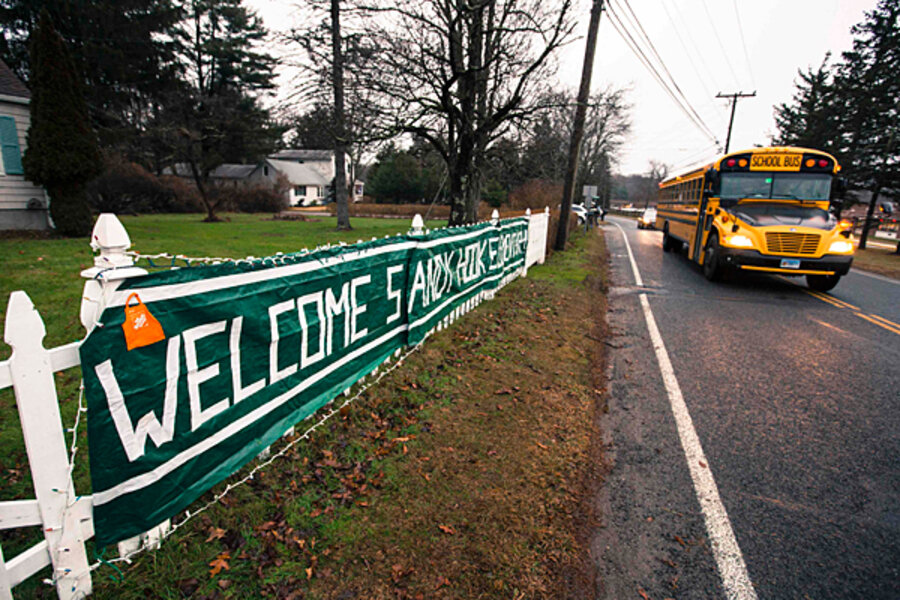Unused school offers Sandy Hook a new home, and path forward
Loading...
The sign is slated to go up Thursday afternoon making it official: Sandy Hook Elementary has a new home, where teachers are already beginning to set up classrooms and families have been touring in anticipation of starting back to school in early January.
Police and grief counselors have been on hand during the rapid transformation of the former Chalk Hill middle school in nearby Monroe, Conn.
It will have the familiar Sandy Hook Elementary School colors of green and white. Even desks and pictures are being moved to the same spots in their new classrooms, to help the students feel at home.
“I said within two hours of hearing about the shooting, ‘You guys are welcome here,’ ” says Monroe First Selectman Steve Vavrek. Hundreds of people have been working around the clock to clean and upgrade the school, and ensure that it will be “the safest school in the country,” Mr. Vavrek says.
Wednesday night he gave a tour to a mother and father whose 7-year-old son has said he doesn’t want to talk about last Friday’s violent shooting that left 20 of his schoolmates dead. “The only thing he’s told his parents is that he heard every gunshot, every noise … [and that] he wanted to pick up his backpack that had $12.64 in it,” Vavrek says.
Thursday morning the boy came in with his grandmother and was able to pick up his backpack, and “he wants to go to school,” Vavrek says.
Other students have been excited to see their teachers setting up, and to see the school’s big gym. So many donations have poured in that plans are under way for a new playground.
Chalk Hill had been unoccupied since 2011 because of declining enrollment. As the new Sandy Hook, it will be governed by the Newtown school district, Vavrek says.
At one point, Sandy Hook Elementary parents thought their children would be scattered to various other schools, Vavrek says, so they were relieved to have the offer of the site, just six miles from the original Sandy Hook school in Newtown.
“The teachers and the parents have been telling me they can never reenter that school,” Newtown superintendent Janet Robinson told CBS News earlier this week. Long term plans for the building are still unclear.
While grieving the loss of Sandy Hook Principal Dawn Hochsprung, some parents also breathed a sigh of relief this week when they heard that former Sandy Hook principal Donna Page is coming out of retirement to help with the transition to the relocated school.
“We were overjoyed,” Karen Dryer, the mother of a Sandy Hook kindergartener, told National Public Radio.
The other schools in Newtown reopened Tuesday, each with separate rooms staffed by counselors for students, staff, and parents, Ms. Robinson told CBS.
The district is taking a flexible approach to allow teachers time off when they need it, says Eric Excell-Bailey, communications director for the American Federation of Teachers (AFT) in Connecticut. State mental health officials have been coordinating counseling services to help in Newtown and beyond.
“Some people, part of their coping mechanism is, ‘I want to get back to work immediately,’ ” Mr. Excell-Bailey says. But a lot of others he talked to in Newtown “said ‘I’m not there yet, I’m not ready to go back.’ The main concern for them about going back too soon was that their fears would translate to the children. But … they also felt guilty that they were not emotionally ready to go back. [Counselors have been helping] them understand that what they’re feeling is normal and that they shouldn’t feel guilty…. They really need to take that time that they need.”
The union has learned several lessons from consultants in a school district in Ohio that endured a shooting tragedy about 10 months ago. For one, counseling and flexibility will be needed long-term.
The emotional response kicks in for many people three to four weeks after the tragedy, Excell-Bailey says, and “there will be some who say ‘I’m fine, I’m fine,’ … but invariably somewhere down the road something will occur that [will] bring it back for them and they might need the support then.”
Teachers are being trained to provide peer support as well.
Schoolchildren from around the state are sending in painted handprints that will be posted all over the new Sandy Hook to greet students in January – “a symbolic gesture of, ‘We’re with you,’ ” says Excell-Bailey.
Fifteen-thousand messages of condolence and encouragement from around the world poured in within the first 24 hours of a mechanism being set up to receive them on the website of the Connecticut AFT.
Groups such as the AFT, the National Education Association, and the Connecticut Department of Education have posted resources for parents and educators to help students cope with the aftermath of the shootings. One resource is the National Association of School Psychologists’ “Talking to Children About Violence: Tips for Parents and Teachers.”
Friday morning at 9:30, Connecticut Gov. Dannel Malloy has requested a moment of silence statewide. Houses of worship and government buildings with bells will ring them 26 times to honor the lives lost at Sandy Hook Elementary.
“We have to move forward,” Superintendent Robinson told CBS News. “It is good for kids to know that we are strong and that as a community we support them.”








